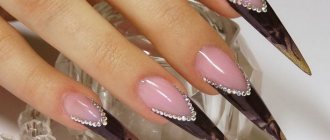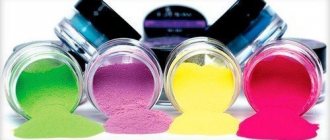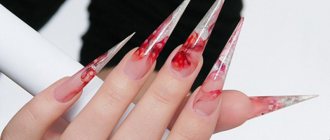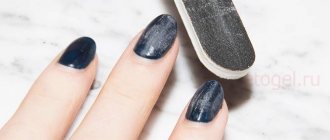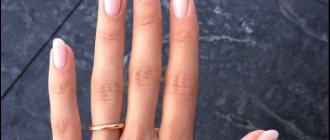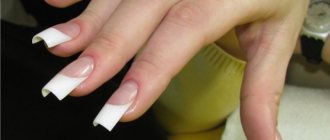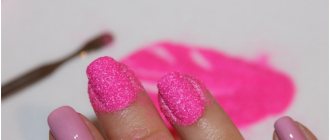Today, modern women are already beginning to forget what nail scissors, a nail file and nail polish remover are. Modern technologies make it possible to extend the life of perfect nails by 2-3 weeks, and throughout this time the coating will look flawless, without the need for correction. At the same time, progress does not stand still, and today fashionistas already have the right to choose materials for covering nails to their taste. Today we want to talk about nail extensions. Gel or acrylic - which is better to use in order to get a perfect manicure for a long time?
The advantage of modern technology
It would seem, why is ordinary varnish bad? But remember, how many women until recently could boast of an ideal shape and were satisfied with the length of their nails? Usually these were just a few, and everyone else was forced to be content with what nature gave. Today, everyone can have their nails the length and shape they want. At the same time, they will be strong, shiny, that is, the same as in the picture. Therefore, it is logical that the vast majority today do nail extensions. Gel or acrylic - which is better to use for this procedure, we will figure it out today.
Gel or acrylic?
In a beauty salon, manicurists are able to turn a client’s unkempt and short nails into real beauty - after painstaking work, the nails acquire a completely presentable appearance.
For nail extensions, you can use gel or acrylic, however, all methods have both advantages and disadvantages:
- The gel is a weak allergenic material that does not have a negative effect on the nail itself. However, if damaged, the nail cannot be restored - if it breaks, it will require complete removal, after which the extension will have to be done again.
- Acrylic is able to harden on its own, without requiring any equipment. In addition, acrylic nails are much easier to remove.
In any case, if you plan to do nail extensions using any of the above methods, you should prepare in advance for a fairly long-term procedure that will take at least 3 hours.
Lack of clear boundaries
Actually this one is like that. Even those women who regularly visit salons do not fully understand what the difference is between these materials. But it lies not only in the properties, but also in the application technology itself, which is more important for the master than for the client himself. The formation of an artificial nail begins with filing of the native nail plate. Then one or another material is applied to it. Acrylic hardens very quickly, which makes it difficult to work with, especially for beginners. Gel, on the contrary, has a fluid structure and takes its final form only under a special lamp. But this also has its downsides. If you leave a jar of gel in the sun, then the time required for one client will be quite enough for it to become completely unusable.
Removal technique
We have only considered application so far. So far there isn't much of a difference. However, 2-3 weeks will pass, and perfect nails will require correction. And here, even without knowledge and experience, you will see how nail extensions differ. Gel or acrylic - which is better, each of you will choose for yourself. But when it comes time to change the coating, the acrylic is removed using a special liquid, and the gel has to be completely cut off, which does not have the best effect on your own nails. Of course, the master will immediately polish everything and make it look better, but if you decide to take a break from such procedures for a while, then your fingers will look very pitiful at first.
Let's summarize the first results so that it is easier for us to draw a conclusion about how to perform nail extensions. Gel or acrylic - which is better? So, the first one is easier to use, but it requires expensive equipment, is susceptible to sunlight and can only be removed by sawing it off. Acrylic is easy to remove, but hardens quickly.
Chemical properties and safety
Women are primarily interested in these parameters, which is not surprising. By the way, there are other materials on the market. These are resin, silk and some others, but they are used extremely rarely, so today we are only considering nail extensions with acrylic or gel. Which is better and why? You can often hear the opinion that gel is useful and acrylic is harmful. How true is this opinion and what is it based on? In fact, this is nothing more than speculation based only on guesswork. The fact is that the gel is very reminiscent of body cream and has practically no smell. But acrylic has a strong chemical smell.
What is acrylic and how does it differ from gel?
Both gel and acrylic are polymers, the only difference is that they harden under different conditions and acrylic withstands temperature changes much better. The materials used for polymer manicure were borrowed from dentistry, where they were tested for strength and ease of use.
The acrylic extension system consists of powder and liquid monomer, which is also called liquid . liquid – liquid.
A feature of the monomer is a sharp and rather unpleasant odor, so craftsmen working with the polymer must take care of a special hood. It is better to do acrylic manicure at home in a well-ventilated area. There is a monomer with a moderate odor, but, judging by the reviews, this system does not last as well.
When working, a special brush is moistened in the liquid and then dipped into the powder. It is saturated with liquid and turns into a dense plastic drop, which, using the same brush, is applied to the nail plate and leveled with trampling and stretching movements, giving it shape. This must be done quickly, as the polymerization process is underway and the acrylic hardens into a solid plate.
Acrylic gives unlimited possibilities for three-dimensional design. It is easy to repair and completely remove if necessary.
Unlike acrylic, gel polymerization occurs in an ultraviolet lamp. The gel does not have such a pronounced odor. There is also a hybrid of these two materials - acrylic, which combines all the advantages of both.
The choice of acrylic or gel will be dictated by the conditions in which the artist works, as well as his skills and experience. Working with acrylic requires greater skill, speed in small movements and a workstation equipped with a hood.
Also, the client may prefer one or another type of material due to the unpleasant odor of acrylic or the presence of an allergic reaction.
And in fact
The chemical properties of these two coating options are practically indistinguishable from each other. They are very similar, and it is very difficult to say which has a greater effect on the nail plates. At the same time, keep in mind that the master will cut off their top layer each time he performs extensions with acrylic or gel. What's better? The effect of these materials on the human body is almost the same. Acrylic just hardens in the air due to its evaporation, and that’s the smell. And the gel hardens under the influence of ultraviolet light, which is why it does not smell of anything.
And again we will summarize the intermediate results. It turns out that the chemical effect of both materials on nails can be ignored. Therefore, do not believe the opinion of friends who, based on unreliable facts, argue whether it is harmful to grow nails. Which is better, gel or acrylic, apparently needs to be clarified further.
Considering reliability
Every woman wants to receive the highest quality service so that she can have a beautiful manicure for a longer time. Therefore, some clients prefer one or another material, based on their own considerations that it is stronger. In fact, the wearability of acrylic and gel is almost the same. But this is only provided that the modeling is done correctly. Not every master works with gel, because it tends to spread. Therefore, naturally flat nails can crack and break. But this is not the fault of the material, it is solely the inexperience of the master. Therefore, it would be wrong to consider nail extension itself bad. Which is better, gel or acrylic, let's find out further.
Contraindications for nail extensions.
By the way, extended or strengthened nails save you from bad habits (squeezing pimples, picking cuticles - this is simply impossible to do with thick nails). Extensions help you get rid of the habit of biting your nails and restore your nail bed. On the other hand, with artificial nails it will be difficult for you to do some useful small work (fasten an earring, chain, etc.)
Methods of nail extensions.
Extension on tips. The word tips itself comes from the English word tip - tip. They are plastic parts for lengthening nails that imitate natural nails. They are produced in various shapes and lengths. They consist of two parts: thin and short - for application to the nail plate - this is the contact zone; the second part is the free edge; the border has the shape of a smile, but there are also homogeneous tips. Tips can be “natural” in color, white, transparent, colored or with a pattern; They also differ in the degree of curvature. Sold in sets. When selecting, pay attention to the shape, size (corresponding to the width of your nails), elasticity and thickness of the tips. When using tips in extensions, it is important to follow the rule: the size of the tips must be the same on both hands! The length is adjusted with a special tool - a tip cutter. The width can only be slightly adjusted by filing in the contact area.
Tip gluing technology.
1. Treatment of nail plates: filing, removing shine with a file, adhesive.
2. Apply glue to the contact part of the tip.
3.Attach tips; The smile zone on the tips and nails must match. Press the tip tightly and then wiggle it a little to get rid of air bubbles. Keep it pressed for 10-15 seconds until the glue dries, remove excess glue with a cotton swab.
4.Using a tip cutter, we shorten the nail to the required length, use a file to give it the required shape, use a buff to align the border between the false nail and the natural one, and also remove the shine from the tips with a file. We treat the tips on top with a degreaser (when adding extensions, you can use a primer, but not for transparent tips, as they may crack).
5. Apply modeling material on top.
Extensions using disposable forms. Forms are special templates with markings that are placed under the free edge of the nails and serve as a temporary substrate on which modeling material is laid out. Disposable forms are sold in rolls and are thrown away after use. Their main advantage is their low price. However, such forms are very naughty, and it is quite difficult to fix them without skill. If necessary, paper forms are trimmed in the contact area with a nail smile. In addition, modeling on paper forms provides a wider range of possibilities, allowing you to design all kinds of shapes of artificial nails. When applying nail extensions to forms, clients should have a free edge of 1-1.5mm.
Reusable forms
for nail extensions have a wire frame and are made of Teflon. Such forms stick firmly to the fingers, but, as a rule, they have standard sizes, so they are not suitable for ladies with too narrow or too wide nail plates, in addition, they cannot be adjusted to the individual shape of the smile. Teflon molds can be used many times, but they also tend to wear out.
Tips or forms?
The forms (usually paper) are removed after finishing the work. They only help to increase the length, and the material is laid out on the nail itself. Tips are plastic plates that are securely attached to your nail and remain with you until you finish wearing your nails. Tips are suitable for very problematic nails with convex side and front pads, when the nail seems to be recessed into them. Then it is impossible to apply the form, although now there are technologies that allow you to apply the form to such problematic nails. Currently, the technology of extension on forms with lengthening of the nail bed is considered more correct. An experienced nail technician can advise which type is suitable for your nail shape and condition.
Pros of forms:
• the bond of acrylic and gel with the nail is much stronger than that of the nail with glue and tips;
• when applying extensions using forms, the master has the opportunity to hide some of the shortcomings of natural nails (grooves, growth to the side), and even hands (visual correction of the curvature of the fingers - the nail is extended slightly with an inclination to the side opposite to the curvature; hands with wide nail plates can make it more elegant);
• on the forms you can model the nail individually (while the tips are standard in shape);
• on the forms you can create nails that are correct in nail architecture (beautiful longitudinal and transverse arches);
• forms look thinner than tips.
Pros of tips:
• the extension procedure takes less time;
• suitable for any length of your own nail. Forms can only be applied if the edge of your nail is at least 1 mm free. If the nails are cut strictly to the root, they will not hold their shape.
⇐ Previous3Next ⇒
Recommended pages:
Material peeling
This is another common problem that also needs to be dealt with separately. Most often, the coating peels off near the cuticle and on the sides. In the vast majority of cases, the master will again be to blame. These are improper preparation of natural nails, incorrect laying out of the material, or processing flaws after extensions. But it also happens that the master did everything right, but this or that material did not suit you personally. But this is no more than 10% of all cases when the client remains dissatisfied with the result.
Possible reasons
It happens that for unknown reasons the body does not accept acrylic or, conversely, gel. Few people have the time to undergo a full examination in a clinic and find out the roots of this phenomenon, so it’s enough to simply trust a specialist who provides nail services. However, in practice it has already been noted that if a woman has hormonal disorders, then acrylic may not hold up well. This may apply during pregnancy and breastfeeding, and may also be associated with taking hormonal medications. In this case, you can try an alternative option. To some extent, the quality of the coating may be affected by the use of antibiotics.
What is better to use for nail extensions: gel or acrylic? This should be said by your master, based on his own experience of working with both materials, as well as from your individual characteristics. If you go to a specialist in your field, then no problems will arise, the coating will be even, smooth and strong.
Gel nail extensions
Dear girls, with my review I may warn someone, someone will remain indifferent, and someone, like me once, will think that this is all nonsense and “this won’t happen to me.”.
But I decided to write anyway, because I myself use your recommendations, they often help me form an opinion and make a decision in choosing a product/service.
How it all began..
2008-2009
I started my extensions with acrylic. I remember that I really liked long extended nails, I considered it the height of well-groomed hands and aesthetics)) Oh the times! Oh morals!))))
Acrylic was my assistant for a short time... in 2010 I completely switched to gel.
I continued to build up the gel for the rest of the time until trouble happened to me.
I have extensive experience in gel extensions, and I am writing a review about it.
Since 2010, I have been growing my nails constantly, with breaks of a month or two at most.
Correction once every 3 weeks..
I won’t talk about the harm that the procedure causes to nails, because... information is available in many sources, and personally, my nails have always been restored, in this I was lucky.
Sometimes I even tore off the extension with my natural one, but it grew back the same as before... Although I have heard a lot of stories about the deformation of the nail plate and even seen such cases.
After removal
I had “pieces of paper” that were susceptible to everything: water, detergent, nail polish, strengthening baths, temperature...
Saved me:
“Smart enamel” - it didn’t make my nails hurt and were “protected” from external factors. Vitamins “Vitrum Beauty” - I take courses of vitamins once every six months to keep the body in good shape and to avoid vitamin deficiency. A remedy that will make your nails start each one will grow strong and long, and regular varnish will last for a week. proven! You can only use it after the nail plate has been completely restored; if it is damaged, it hurts.
At some point, being a person already experienced in this matter, I decided to increase it myself..
2013, November.
I bought everything I needed for extensions and started making beauty on my hands...
My joy and happiness knew no bounds, only the process itself is tiring until my hand is “full”, but the result brought me a lot of pleasure - I couldn’t be happier)))
I am my own designer - I got what I wanted 100% because I knew how to do it!
Extended nails. My job. Extended nails. My job.
Through trial and error, many viewings of training videos, master classes at the exhibition and express courses, I learned everything I needed.
They complimented my manicure, and several girlfriends asked me to do it for them too, and then their girlfriends asked and I did it.
I tried it and it worked! Clients appeared, there were a small number of regulars. I seriously thought about turning my hobby into a job. I really enjoyed this activity.
Extended nails. My job. Extended nails. My job. Extended nails. My job.
September 2014.
10 months have passed since the start of my activities related to extensions.
I was preparing financially and mentally for the training course in order to receive a certificate, increase the level of knowledge and continue my development in this matter.
The course started in October.
On average, I was in contact with the material 3 times a week, and over the course of 5 years I was in contact less often, but regularly.
Another correction, after the procedure the client is happy, and so am I.
In the evening after she leaves, my hands begin to itch and irritation and watery bumps appear between my fingers, which hurt and cause discomfort.
I would like to note that I am not allergic.
Creams/ointments don’t help, all sorts of tinctures are powerless... I’m going through the reasons why this happened and in general WHAT IS THIS!!!??? - the solution has come - Allergy to grapefruit!!
It’s strange, I ate for my health and everything was fine, but here it is. Of course, I excluded grapefruit and started taking anti-allergy medications, but the problem was not completely eliminated.
Only after 7 days, without contact with extension products, my hands stopped itching.
I was happy) I breathed a sigh of relief and hated grapefruit forever!!
A client calls, her nail is broken, asks to help out... - no question!
When I came, I started to wash my nails and my hands started to itch...
By the end of the nail repair, I couldn’t stand it anymore, it hurt... there were pimples again...
Understanding the true cause of my allergies, contact dermatitis, to be more precise, I could not accept for a long time - after all, this is fraught with cessation of activity. But whatever one may say, I had to come to terms with it. My husband forbade hair extensions and was categorical in his decision.
Contact dermatitis is a skin reaction that occurs as a result of exposure to allergens or irritants.
I myself understood that allergies are forever, because... Toxic substances contained in the material are cumulative in nature and are not removed from the body at all. And I breathe them while working, and make tactile contact.
All this happened a few days before I was going to pay money for training (the courses are expensive).. It was very difficult for me, but I had to give up my dreams and plans.
“So it’s necessary,” I reassured myself.
What is important to know:
This happens to all masters. Without treatment, you can only eliminate the symptoms. Dust accumulates in the lungs and remains there. Clients who have been building for a long time and regularly may also begin to suffer from allergies.
NO ONE KNOWS HOW YOUR BODY WILL REACT TO SUCH TOXIC STRESS! THIS IS ACTUALLY DANGEROUS.
If you extend your nails and do the correction once every 3 weeks, the contact is rare and therefore the allergy will happen later, when the “necessary” amount of the substance has already accumulated.
And for a master who comes into contact with the material every day, the process will start significantly faster!
Many people live and work with this, but I decided that my health is more important to me.
Like this.
A year later, I tried to make myself gel polish, no allergies showed up, so I did it again, ruined my nails and now I am restoring them.
Gel polish:
Gel polish on my nails.
When the nails and the coating didn’t look neat, I painted the top with varnish to last until the manicure :)
Regular polish on top of gel polish. Another coating:
Gel polish on my nails. Natural nails:
My natural nails are covered with regular polish. My natural nails are covered with regular polish. My natural nails are covered with regular polish. My natural nails are covered with regular polish. My natural nails are covered with regular polish.
Girls, I will not recommend nail extensions from a health point of view.
We need to take care of ourselves and exclude negative factors that we can exclude.
But from the point of view of beauty and convenience, I give it 5+. Nowadays, progress in the development of the nail industry has stepped forward, as has eyelash extensions, and there are hundreds of design options, for every taste))
If you want, do it, but as soon as you notice an allergy, think about it, this is an alarm bell!
Thank you for reading my story, I really want it to be useful!
I wish us to be healthy, beautiful and happy)))
Hand creams that I recommend:
Velvet cream. Necessary for the winter. Protection and first aid for hands. Silk cream.
Review of eyelash extensions.
PrincessAღ
Gel extensions, pros and cons
So, we looked at the features of both materials. They are not very different in their characteristics, so choosing which is better is quite difficult. Let's once again summarize what properties acrylic or gel have. Which is better, the pros and cons of each. Do not forget that this information must be consistent with the opinion of your master.
So, the advantages of the gel:
- Extensions can be performed on tips, that is, overlay plates, which gives you the opportunity to wear nails of any length.
- Even a novice master can perform this procedure.
- The nails are very durable.
- During the procedure, the master and the client are not bothered by an unpleasant odor.
- Gel nails last up to 4 months, however, the growth of the base of the nail plate will still lead you to correction much earlier.
- An abundance of decorations and flowers.
Minuses:
- Even an amateur can immediately see that these are gel nails. They are much thicker than usual.
- Strong temperature changes lead to cracks.
- A broken plate cannot be repaired, only replaced.
- You cannot make a three-dimensional design with gel.
- Beginners often work with gel, which is why the quality of the final coating may be poor.
Advantages and disadvantages of the procedure
An interesting fact is how this technology has penetrated into nail salons. It was primarily dentists and stomatologists who used acrylic in their work, since its hardness is ideal as a dental material.
Over time, namely in 1957, the idea of nail extensions was born in the world of manicure, and then leading specialists tried this material in order to introduce something new and spectacular into the manicure field. Until today, this technology is one of the leading ones in working with nails.
There are many advantages of acrylic nails that will equip you with the subtleties of manicure:
Acrylic adds elasticity and therefore naturalness to manicure.
- this material gives elasticity , and therefore naturalness to the manicure;
- thinness and, at the same time, strength of nails due to the absence of toxic methyl methacrylate in the composition;
- insensitive to temperature;
- more durable than other materials that are used for the same purpose (gel for example);
- can be easily removed if necessary (in a special solution);
- versatile design (artistic, aquarium, volumetric);
- easy restoration in case of breakdown.
At the same time, we will not hide some of the disadvantages of such a procedure, because we want the best for you:
- “lifelessness” of the nail , which is under the influence of acrylic;
- "dental" smell;
- possibility of temporary loss of natural shine;
- the need to first use a base varnish and only then an acrylic material to give the desired color;
- the need for leveling and sanding after application;
- Possibility of allergy to the material.
With cosmetic procedures, everything is not always so simple, there are always pros and cons to whatever you use. It is true what they say: “Beauty requires sacrifice,” and, unfortunately, this is so. But most of these disadvantages when working with acrylic manicures can be avoided if you use the technology correctly, which we’ll talk about next.
Acrylic coating, pros and cons
Let's start with the strengths.
- Extensions can be done on tips or your own nails.
- The high-quality coating is very durable, resistant to chemical and physical influences.
- These nails are thinner and therefore look more natural.
- They are subject to restoration and repair.
- Removable without cutting.
- Wide possibilities for three-dimensional design.
Here are some of the downsides:
- Using liquid with acetone causes acrylic to lose its shine.
- The extension is accompanied by a strong odor.
- May cause an allergic reaction.
- High-quality extensions require a high level of professionalism from the specialist.
